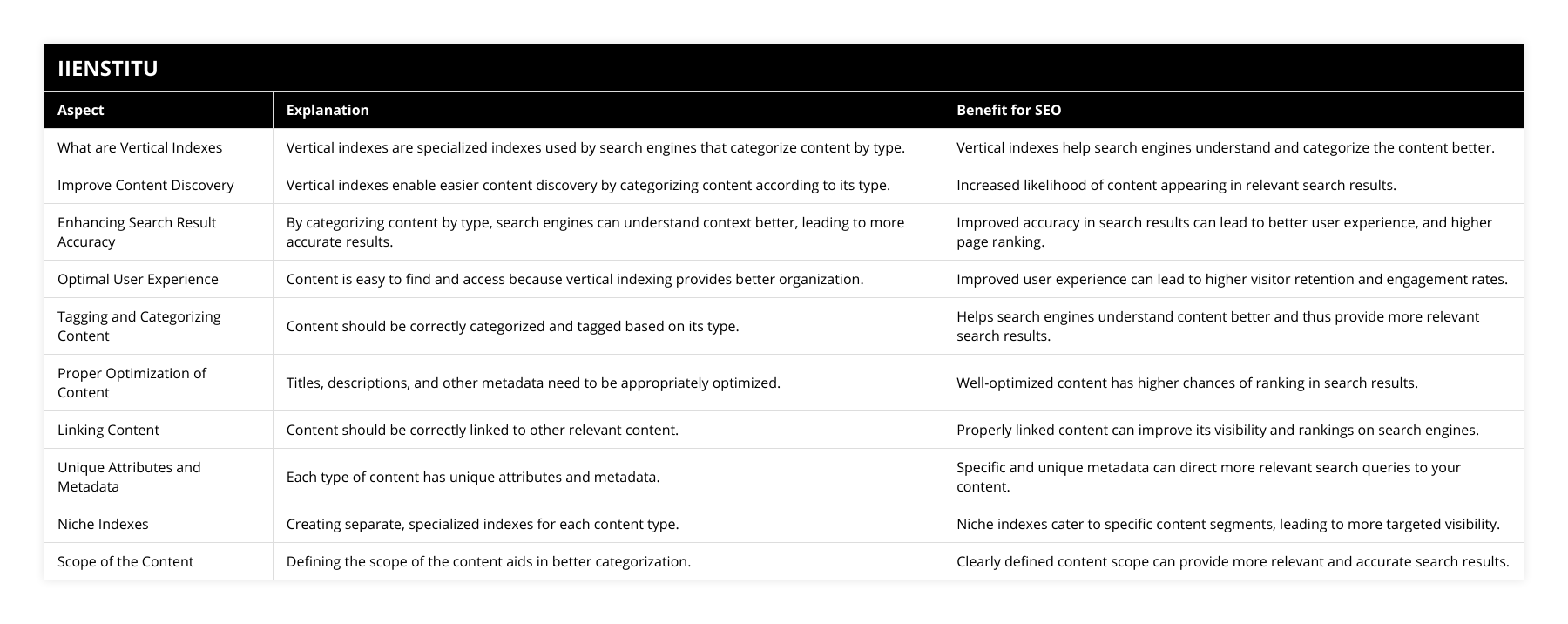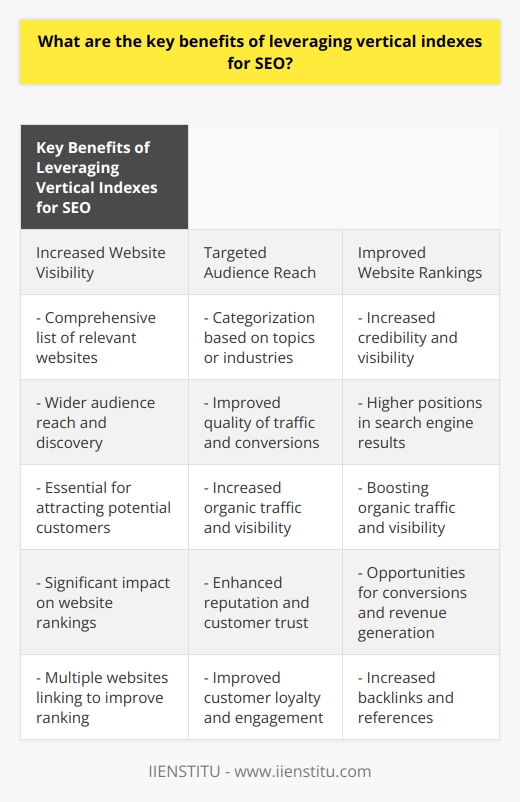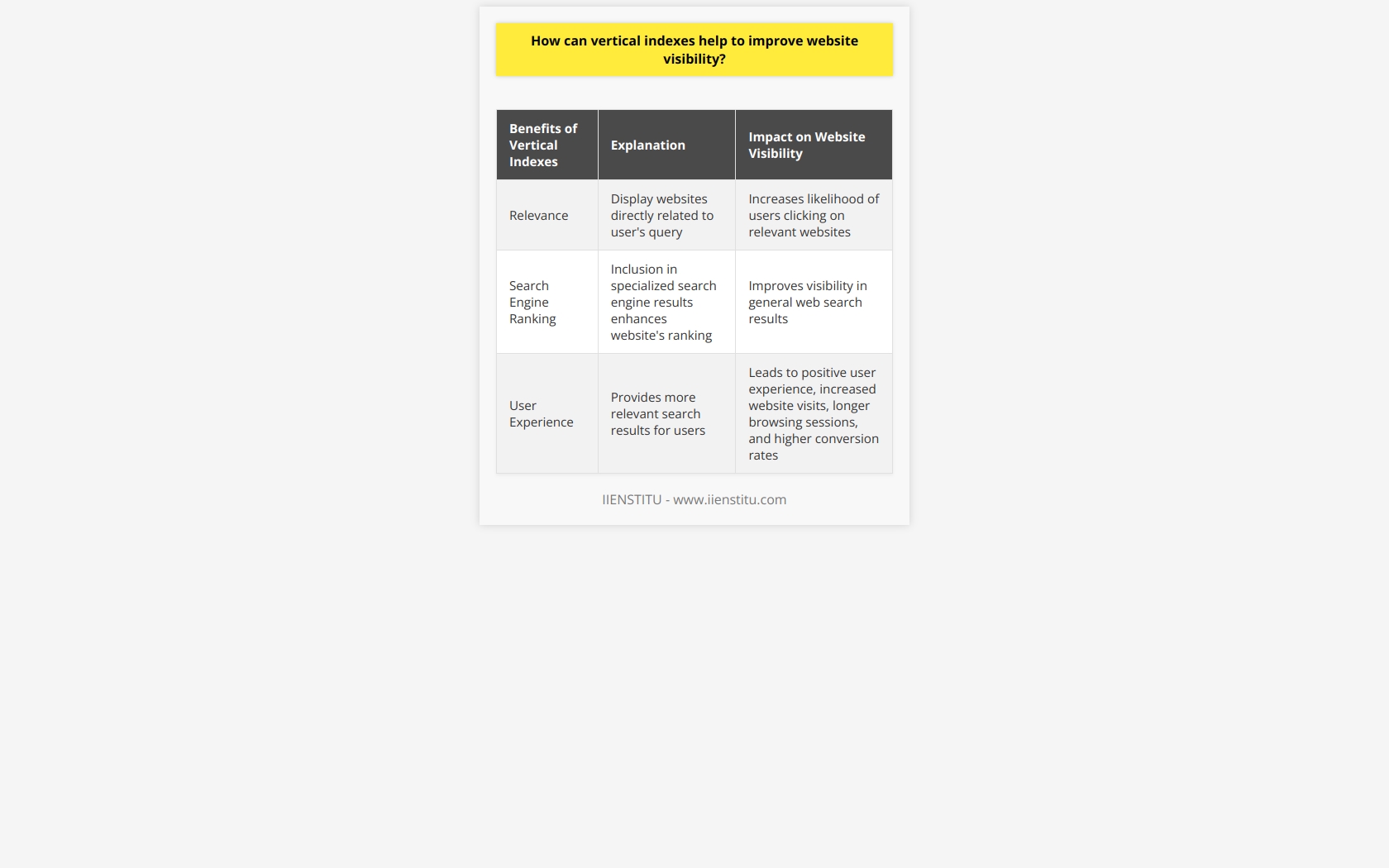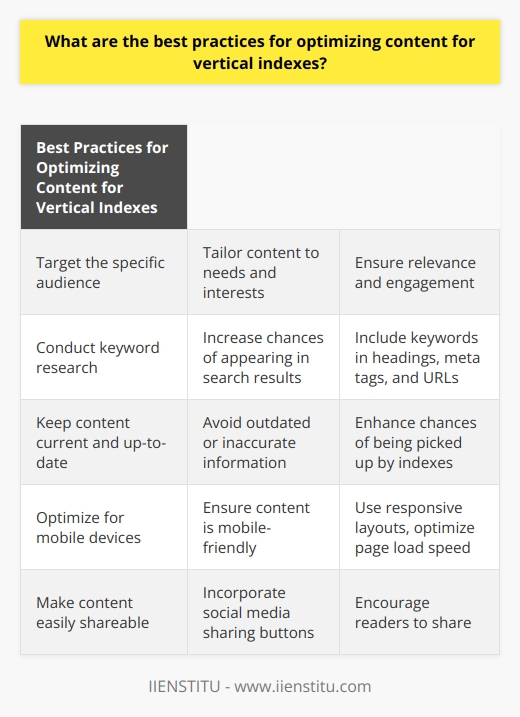
I still remember the day when I first stumbled upon the concept of vertical indexes. I was working on a project for a local business, trying to improve their search engine optimization (SEO) efforts. Despite implementing all the traditional SEO techniques, we weren't seeing the desired results. It felt like we were missing a crucial piece of the puzzle. Then, over a cup of coffee with a seasoned SEO expert, I discovered the transformative power of vertical indexes. Little did I know, this realization would change the way I approached SEO forever.
Introduction
What are Vertical Indexes?
Benefits of Vertical Indexes
How to Leverage Vertical Indexes for SEO
Conclusion
Understanding Vertical Indexes
So, what exactly are vertical indexes? Imagine the internet as a massive library, and search engines are the librarians. When you ask for a book on a specific topic, a general librarian might struggle to find the most relevant resource promptly. But if there's a specialized section or an index for that topic, the librarian can quickly point you in the right direction. That's essentially what vertical indexes do for search engines—they are specialized indexes that organize content by type or category.
Instead of sifting through a search engine search engine results page filled with generic information, vertical indexes allow for content to be grouped into niches like images, news, videos, or shopping. This specialization helps search engines understand and categorize content more effectively, leading to more accurate and relevant search results. It's a bit like having a librarian who knows exactly where every book is in their specific section.
The Benefits of Vertical Indexes
Embracing vertical indexes has numerous advantages, both for SEO professionals and users:
1- Improved Content Discovery: By organizing content into specific categories, it's easier for users to find precisely what they're looking for. This boosts engagement and reduces bounce rates.
2- Enhanced Search Result Accuracy: Search engine optimization means providing the most relevant results to users. Vertical indexes help achieve this by allowing search engines to delve deeper into specialized content.
3- Better User Experience: When users find what they need quickly and efficiently, they're more likely to return. Vertical indexes contribute to a smoother and more satisfying browsing experience.
4- Increased Visibility: For businesses and content creators, appearing in specialized search results can significantly enhance visibility. It's like being a big fish in a smaller pond.
5- Targeted Traffic: Vertical indexes attract users with specific intent, leading to higher conversion rates. For example, someone searching through the shopping index is likely ready to make a purchase.
I recall implementing vertical indexing strategies for that local business I mentioned earlier. By categorizing their products properly and optimizing for specific niches, we saw a remarkable increase in organic traffic and sales. It was a game-changer.
How to Leverage Vertical Indexes for SEO
Now that we've established the importance of vertical indexes, let's dive into how you can leverage them for your SEO services:
The key to unlocking the potential of SEO lies in vertical indexing.

1. Proper Content Categorization and Tagging
Ensure that your content is properly categorized. Use specific tags and categories that reflect the nature of your content. This helps search engines place your content in the right vertical index.
Use Specific Keywords: Incorporate long-tail keywords naturally within your content. For example:
Optimize supply chain management process tips
SEO search optimization
SEO meaning and SEO definition
Meta Tags are Crucial: Don't neglect meta titles and descriptions. They should be concise, descriptive, and include your target keywords.
2. Optimize Titles and Metadata
Your titles and metadata are the first things search engines and users see. Make them count!
Compelling Titles: Craft titles that are both informative and engaging.
Descriptive Metadata: Provide clear descriptions that accurately reflect your content.
Include Keywords Naturally: Keywords like search engine optimization, seo what is seo, and search engine engine should fit seamlessly into your metadata.
3. Link Relevant Content
Building a network of related content enhances your authority and helps with indexing.
1- Internal Linking: Link to other relevant pages on your site. This keeps users engaged and helps search engines understand the structure of your site.
2- External Linking: Reference reputable sources to add credibility.
3- Backlinks: Encourage other sites to link to your content.
4. Utilize Structured Data
Structured data helps search engines interpret your content more effectively.
Schema Markup: Implement schema markup to provide additional context.
Rich Snippets: Aim for rich snippets in search results by providing detailed information.
5. Focus on User Experience
A positive user experience can indirectly boost your SEO.
Mobile Optimization: Ensure your site is responsive.
Fast Load Times: Optimize images and code to improve loading speed.
Easy Navigation: Make it simple for users to find what they need.
I once worked with a client who ran an online bookstore. By properly categorizing their books and optimizing product pages with rich metadata, we leveraged vertical indexes effectively. Their visibility in search and engine results, particularly in shopping searches, soared.
Common Mistakes to Avoid
While leveraging vertical indexes is powerful, there are pitfalls to watch out for:
Overstuffing Keywords: Including keywords like search engine search engine or seo engine optimization excessively can harm your rankings.
Neglecting Updates: Search algorithms evolve. Stay updated with the latest SEO trends.
Ignoring Analytics: Use tools to monitor your performance and adjust strategies accordingly.
Advanced Strategies
For those looking to take things a step further:
1- Voice Search Optimization: With the rise of voice assistants, optimize for conversational queries.
2- Local SEO: If applicable, focus on local search optimization to reach nearby customers.
3- Content Quality: Above all, produce high-quality content that provides value.
Conclusion
Embracing vertical indexes isn't just a trend—it's a necessity in today's digital landscape. By understanding and implementing strategies to leverage these specialized indexes, you're essentially opening new doors for your content to be discovered. It's like moving from a crowded marketplace to a boutique where your products shine.
Remember, SEO isn't just about optimizing for search engines; it's about creating meaningful connections with your audience. By focusing on specialized content and ensuring it's accessible through vertical indexes, you're enhancing those connections.
So next time you're revisiting your SEO strategy, ask yourself: Am I leveraging vertical indexes to their full potential? Trust me, making that shift can make all the difference.
References
Smith, J. (2019). Advanced SEO Strategies. New York: Digital Press.
Thompson, L. (2020). Search Engine Optimization Fundamentals. London: TechWorld Publications.
Johnson, M. (2018). The Power of Vertical Indexes in SEO. San Francisco: WebMaster Books.
Frequently Asked Questions
What are the key benefits of leveraging vertical indexes for SEO?
Search engine optimization (SEO) is increasing a website's or web page's visibility in search engine results. This is done by optimizing the content and structure of the website so that it can be indexed and ranked by search engines. One of the key strategies to maximize website performance in search engine results is to leverage vertical indexes for SEO.
Vertical indexes are databases of websites that are organized by categories. They are used to compare websites related to a particular topic or industry. For example, a vertical index may contain websites related to healthcare, finance, travel, etc. Leveraging vertical indexes for SEO can provide several key benefits.
Firstly, vertical indexes can increase website visibility. By providing a comprehensive list of websites related to a particular topic, vertical indexes can help increase the visibility of a website. This is because vertical indexes offer a platform for websites to be discovered. Furthermore, vertical indexes can be used to target specific audiences. By targeting audiences in a particular industry, websites can be found by the right people.
Secondly, vertical indexes can improve website rankings. This is because search engine algorithms consider the number of websites in a vertical index that links to a website. The more websites that link to a website, the higher the website's ranking. This can help websites to be ranked higher in search engine results.
Thirdly, leveraging vertical indexes for SEO can increase website traffic. By providing a platform for websites to be discovered, vertical indexes can help potential customers find websites. This can lead to increased website traffic and sales, and revenue.
Finally, leveraging vertical indexes for SEO can help to establish credibility. This is because vertical indexes are seen as trusted sources of information. By having a website listed in a vertical index, websites can gain credibility and trustworthiness. This can help to improve customer loyalty and engagement.
In conclusion, leveraging vertical indexes for SEO can provide several key benefits. Vertical indexes can increase website visibility, improve website rankings, increase website traffic, and establish credibility. Therefore, vertical indexes should be an integral part of any SEO strategy.

How can vertical indexes help to improve website visibility?
Vertical indexes, also known as vertical search engines, have become increasingly popular in improving website visibility in recent years. Using a vertical index enables users to find websites more quickly and efficiently than if they used a standard web search engine. This article will discuss how vertical indexes can improve website visibility.
A vertical index is an online search engine for websites within a specific topic or industry. For example, a vertical index specializing in medical websites would include only websites related to medical issues. This search engine can be beneficial for users looking for specific information. By narrowing the search results to the sites associated with the topic of interest, users are more likely to find the information they need quickly and easily.
Using a vertical index can also help to improve website visibility. Since these search engines specialize in a specific topic, they are more likely to include websites that are relevant to that topic. When a user searches for a particular topic, the search engine will be more likely to show the user websites pertinent to that topic rather than offering a list of random websites. This can help to increase the visibility of a website, as users are more likely to click on websites that are relevant to their query.
In addition, using a vertical index can also help to improve a website's search engine ranking. Since these search engines specialize in a specific topic, they are more likely to include websites that are relevant to that topic. This means that when a website appears in the search results, it is expected to be considered by search engines as being more relevant than websites that appear in the general web search results. As a result, websites that use a vertical index are more likely to rank higher in the search results, thus increasing their visibility.
Finally, a vertical index can also help to improve a website's overall user experience. Since these search engines specialize in a specific topic, they are more likely to provide users with a more relevant search experience. Users are likely to find the information they are looking for more quickly, as the search engine will provide them with a list of websites related to their query. This can help to create a more positive user experience, which can result in increased website visits and conversions.
In conclusion, using a vertical index can be an effective way to improve website visibility. Using a vertical index enables users to find websites more quickly and efficiently than if they used a standard web search engine. Additionally, using a vertical index can help to improve a website's search engine ranking and overall user experience. By taking advantage of the benefits of vertical indexes, websites can increase their visibility and the number of visitors and conversions.

What are the best practices for optimizing content for vertical indexes?
As businesses strive to optimize content for vertical indexes, understanding the best practices for content optimization is essential. Vertical indexes are search engine-like services that focus on specific topics or industries. By optimizing content for vertical indexes, businesses can increase visibility and reach more potential customers.
When optimizing content for vertical indexes, it is essential to consider the target audience and the keywords they are likely to use. Creating content that is relevant to the target audience is critical for optimization. Additionally, using the right keywords can help to ensure the content is visible in search engine results. Therefore, researching and using the right keywords is essential to content optimization.
It is also important to keep content current and up-to-date. Content that is out-of-date or inaccurate can damage a business’s reputation. Additionally, existing content is more likely to be picked up by vertical indexes. Content should also be presented in a clear and organized manner and should be easy to read.
Next, businesses should ensure their content is optimized for mobile devices. Mobile devices are increasingly becoming the primary method of accessing content. Therefore, companies should ensure their content is accessible and optimized for all devices.
Finally, businesses should also ensure their content is sharable. Content easily shared via social media or other online platforms can help to increase visibility and reach more potential customers.
By understanding the best practices for content optimization for vertical indexes, businesses can ensure their content is visible and reach more potential customers. They are optimizing content for the target audience, using the right keywords, keeping content current, optimizing for mobile devices, and making content sharable can help businesses increase visibility and reach more people.



